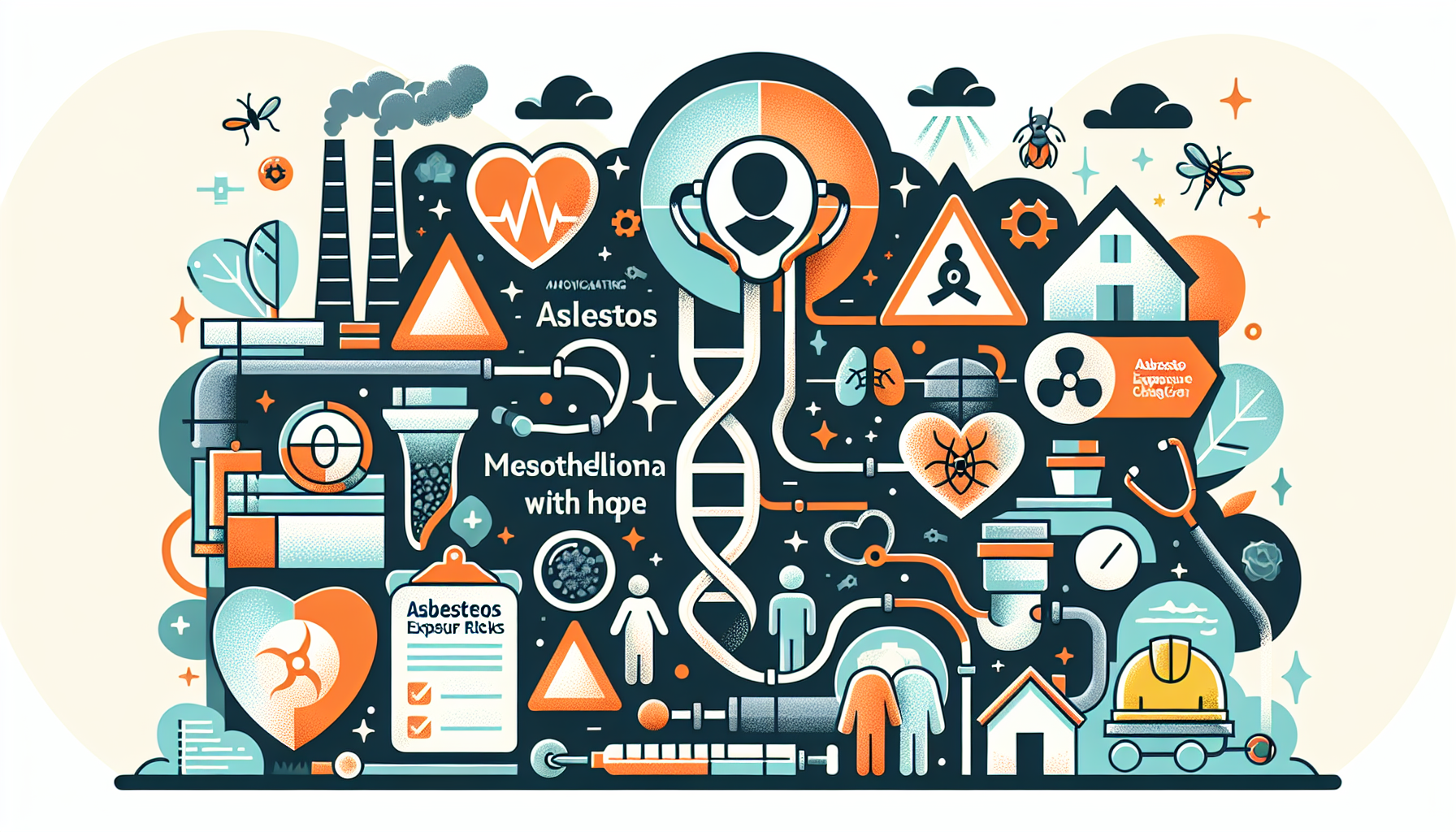Asbestos Exposure Risks in Mesothelioma: A Personal Journey of Hope & Support
When I first encountered the term mesothelioma, following a history of asbestos exposure risks, the world suddenly felt overwhelming. I found solace in sharing my story, hoping that each word might provide comfort, clarity, and guidance to others in a similar situation. Today, I want to be your trusted companion, walking alongside you on this challenging path, offering both factual information and emotional support.

Understanding Asbestos Exposure & Its Role in Mesothelioma
Asbestos exposure is a common precursor in many mesothelioma cases. In my journey, understanding how tiny fibers can lead to a significant health challenge was both frightening and enlightening. I soon realized that being informed is the first step toward empowerment. Here’s a brief rundown on the risks:
- Direct Risk: Continuous inhalation of asbestos fibers can cause lung and pleural issues.
- Long-Term Effects: Mesothelioma may develop decades after exposure.
- Prevention: Engaging professional asbestos removal, abatement, testing, and inspection services is essential.
I remember seeking a certified asbestos testing near me and professional asbestos abatement companies, ensuring that my home and work environments were safe. Each step was both practical and emotional, as I navigated my concerns about my loved ones.
Figure 1: A supportive community coming together to understand asbestos exposure risks and mesothelioma.
My First Encounters with Diagnosis and Staging
When the diagnosis first came into my life, it was as if a storm had set in. I recall the overwhelming feelings that mixed fear and uncertainty. Doctors explained that mesothelioma is typically staged from 1 to 4, with Stage 1 being the earliest and Stage 4 being the most advanced. Understanding the biopsy methods, whether through thoracoscopy or thoracentesis, became crucial in grasping the journey ahead.
This part of my journey involved many questions: How quickly should I move forward with treatment? What are the realistic outcomes for each stage? In every discussion with my oncologist, I felt the need to understand not just the medical jargon, but what it truly meant for my day-to-day life.
Diagnosis & Staging Explained
The staging system in mesothelioma provides a roadmap to help guide treatment options. My doctor explained:
- Stage 1: Localized disease. Treatment options often focus on surgical removal along with chemotherapy.
- Stage 2 & 3: Local spread to adjacent organs. Here, multimodal therapy, combining surgery, chemotherapy, and radiation, is typically recommended.
- Stage 4: Advanced disease. The focus is on palliative care, immunotherapy (for example, Nivolumab/Ipilimumab), and quality of life improvements.
Having this breakdown helped me prepare for the various steps I might have to take and reassured me that my medical team was committed to exploring every possible avenue for treatment.
Navigating Treatment Options Together
As I continued my research, understanding different treatment modalities became a lifeline. From exploring affordable asbestos removal services to connecting with reliable asbestos remediation contractors in my area, each step confirmed the need for clarity and precision in both medical and environmental safety measures.
I learned detailed aspects about:
- Immunotherapy: This treatment boosts the body’s immune response against cancer cells. Drugs like Nivolumab/Ipilimumab have become a beacon of hope in many cases.
- Multimodal Therapy: Often involving a combination of surgery, chemotherapy, and radiation, this comprehensive approach aims to attack cancer from multiple fronts.
- Clinical Trials: As scary as it sounds, participating in clinical trials offered me a chance to access cutting-edge treatments while contributing to future research.
Every treatment option was weighed carefully with my doctor, and I made sure to ask for all the details, from benefits and risks, to potential side effects. This detailed exchange made the decisions feel collaborative and respectful of my autonomy.
Figure 2: A diagram illustrating treatment options and pathways, helping demystify complex concepts.
Coping with the Emotional Waves: Strategies & Reflections
Living with mesothelioma is not solely about the physical manifestations of the disease; it’s also about managing emotional and mental turmoil. I want to share some strategies that helped me bridge the gap between fear and acceptance:
- Talking Openly: Sharing my anxieties with family and support groups provided relief and allowed me to feel less isolated.
- Mental Health Support: Regular sessions with a counselor and mindfulness practices became my anchors in troubled times.
- Journaling: Documenting my journey enabled me to reflect on small victories, learn from setbacks, and stay grounded in the face of uncertainty.
- Community Engagement: Being part of online and local support groups meant that I was never truly alone. Hearing stories of hope from people who had weathered similar storms was transformative.
You may find it helpful to note down small steps each day that reaffirm your strength. For example, creating a simple daily checklist of acts of self-care can be an effective way to manage overwhelming feelings. My routine now includes a morning meditation, afternoon walks, and an evening check-in with loved ones.
A Personal Reflection: Finding Meaning in the Midst of Chaos
A Personal Reflection: There were moments when my heart was full of despair. But even on the hardest days, I discovered small windows of hope and strength. Speaking from my own experience, I learned that truthfully sharing our vulnerabilities creates space for healing. It is in these shared moments of struggle and resilience that we, as a community, find our capacity to move forward.
Through this journey, I have also become more aware of the importance of environmental safety measures. I have actively sought out professional asbestos remediation services, knowing that protecting my home and environment is part of safeguarding a healthier future for my family.
Your Next Steps: A Step-by-Step Guide
If you’re at the beginning of this daunting journey, here is a step-by-step guide that helped me when I first faced my diagnosis:
- Confirm Your Diagnosis: Seek a second opinion, learn about biopsy procedures such as thoracoscopy, and understand your pathology report.
- Understand Staging: Ask your doctor to explain the staging system clearly. Knowing your stage can help you plan treatment options more confidently.
- Connect with Specialists: Look for mesothelioma specialists and cancer centers. Trustworthy resources include the National Cancer Institute and American Cancer Society.
- Build Your Support Team: Surround yourself with loved ones, join support groups, and don’t be afraid to seek professional counseling.
- Stay Informed: Regularly consult reputable sources. Keep an updated list of questions for your next doctor’s appointment.
This checklist is not exhaustive, but it has been an anchor for me. It reminded me that every step, no matter how small, is progress.
Resources and Internal Links
For further reading, please visit our related articles on Mesothelioma Treatment Options Explained and Living with Mesothelioma: Supportive Resources. These resources delve deeper into practical strategies and real-life stories shared by fellow survivors.
From My Heart to Yours: Words of Encouragement
I know that facing a diagnosis like mesothelioma can feel like an insurmountable challenge. But please remember, every single day offers a new opportunity for hope, courage, and strength. Reach out, ask questions, and know that you are not alone in this fight.
Information on treatment guidelines current as of October 2023.
Disclaimer: This content is provided for informational purposes only and should never replace professional medical advice. Always consult with a healthcare professional regarding any medical concerns.






